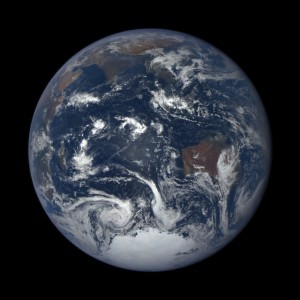Atmospheric Dynamics
 The extra-tropical atmosphere is populated with turbulent motions on a variety of scales. The largest and most energetic eddies in the atmosphere have scales in excess of 1000km, while the large eddies in the ocean are typically on the order of 100km in size. These large-scale geostrophic eddies play a critical role in the climate system, as they are a major contributor to the transport of heat and other properties. In particular, almost all the atmospheric transport of heat from the subtropical latitudes to the polar regions, is achieved by turbulent eddies and waves. Understanding the character of these eddy transports is crucial if we want to understand the response of the planets climate, and in particular the equator-to- pole temperature gradient, to changes in the external forcing, such as encountered with past and future climate change. Our group investigates the role of turbulent eddies in the atmosphere (and also in the ocean–check our research on ocean turbulence.)
The extra-tropical atmosphere is populated with turbulent motions on a variety of scales. The largest and most energetic eddies in the atmosphere have scales in excess of 1000km, while the large eddies in the ocean are typically on the order of 100km in size. These large-scale geostrophic eddies play a critical role in the climate system, as they are a major contributor to the transport of heat and other properties. In particular, almost all the atmospheric transport of heat from the subtropical latitudes to the polar regions, is achieved by turbulent eddies and waves. Understanding the character of these eddy transports is crucial if we want to understand the response of the planets climate, and in particular the equator-to- pole temperature gradient, to changes in the external forcing, such as encountered with past and future climate change. Our group investigates the role of turbulent eddies in the atmosphere (and also in the ocean–check our research on ocean turbulence.)
Atmospheric Turbulence
The nature of the turbulent fluxes in the atmosphere changes with latitude. In the tropical troposphere, the saturated moist entropy is well mixed in the vertical: this well homogenized state is marginally critical to convective instability and turbulence acts to maintain the system in equilibrium. In the midlatitude atmosphere the nature of turbulence is more complex. Here the turbulent eddies originate from baroclinic instabilities of the mid-latitude jets, and feed on the available potential energy associated with the equator-to-pole temperature gradient. Unlike convective instability, which primarily redistributes properties in the vertical, baroclinic eddies redistribute entropy and momentum both in the horizontal and in the vertical. There is no agreed upon theory on how the baroclinic flow equilibrates, and this is a topic of research in our group [1].
Now working on this theme: Grace O’Neil.
Previously working on this theme: Malte Jansen.